
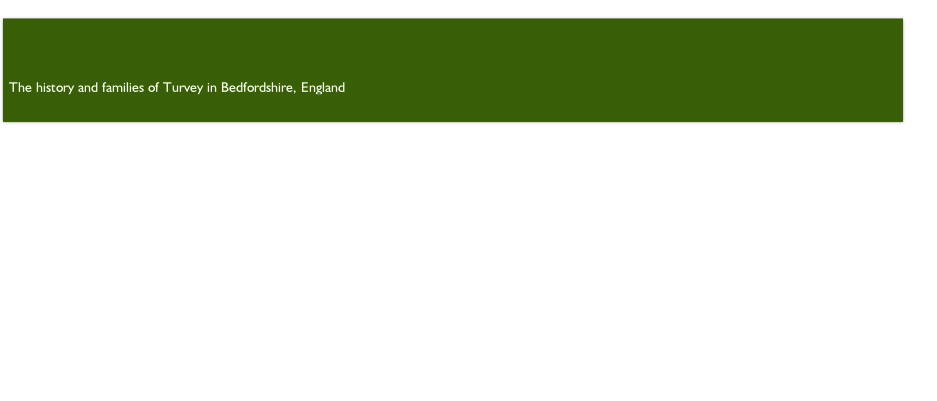
©2011 Deborah Richardson

Privacy Policy
Copyright

The Mordaunt family are buried in the Church at Turvey. They held the title 'Baron of Turvey' and later became Viscounts and then the Earls of Peterborough. Here is more information on the Mordaunts of Turvey....
The family was believed to have been founded by Osbert le Mordaunt who was a knight with William the Conqueror and came to this country immediately after the Norman Conquest (1066). Of course many noble families claimed just such a descent so this may not really be the case at all! However, William I did indeed hold possession of 'the lordship of Turvey in the county of Bedford' so it is not impossible.
One of the earliest mentions of Mordaunts as Lords of the Manor in Turvey is Edmund Mordaunt "of whom it is stated in an inquisition taken in 1372 that on the Sunday before the Feast of St. Simon and St. Jude in that year, being seized with homicidal mania, he killed his wife Ellen and drowned himself on the same day in a pool in Turvey."
Edmund's son, Robert Mordaunt, was born on 19 March 1368, in Cople in Bedfordshire. He was married to the rich heiress, Agnes le Strange. He died on 21 September 1442, also in Cople
Robert was succeeded by another Robert, who was born on 27 July 1410 and in 1449. He married Elizabeth Holdenby of Essex.
William Mordaunt 19 Feb 1432 -
The oldest son of Robert Mordaunt, William married Margaret, the daughter of John Peake of Cople in Bedfordshire. They had three children. Margaret died in 1496.

The Mordaunt arms are heraldically described as:
Argent, a chevron between three estoiles Sable
Sir John's effigy is in the church at Turvey (his armour was also kept in Turvey Church for
many years)
His parents were William Mordaunt and Margaret.. John Mordaunt inherited the estate on his
father's death in 1481. He was appointed Chancellor of the Duchy of Lancaster for life in the
reign of Henry VII. He claimed he was eleventh in descent from the family founder, Osbert.
He fought, and was wounded, at the battle of Barnet with the Earl of Warwick and also saw
action at Bosworth Field and was a commander at the battle of Stoke (1487) -
Sir John's wife was Lady Edith, the daughter and heiress of Sir Nicholas Latimer of Duntish in Dorset. She was the widow of John Greene of Stotfold.
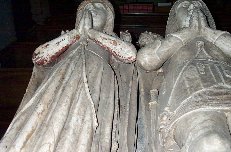
John Baron Mordaunt of Turvey Abt 1483 in Cople, Beds - 1561
Sir John and Lady Edith's eldest child was another John and he was made the first Baron Mordaunt of Turvey by King Henry VIII in 1529. His wife was Lady Elizabeth Vere, the daughter of Sir Henry Vere of Addinton, and they are both buried in the Chancel. As well as a wife, the baron acquired the lordships of Drayton and Thrapston as a dowry.
John was a politician and the first Custos Rotulorum of Bedfordshire ("Keeper of the Rolls", the highest civil office in the county) .He was succeeded by his son, John.
Sir John aquired a lot of monastic land and became very rich.
The picture on the left is of John and Elizabeth's grand tomb in Turvey Church.
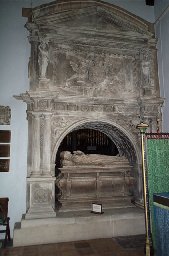
John, 2nd Baron Mordaunt of Turvey About 1508 - Between April and October 1571
at Turvey
The second Lord Mordaunt, was yet another John, and born at Turvey. His first wife was
Lady Eleanor FitzLewis. the daughter of Sir Richard Fitzlewis of West Thorndon, Essex, whom
he married sometime before 26 February 1526.
Eleanor died on 2 June 1543 and John remarried. His second wife was called Lady Joanna.
When they met, during the rising in behalf of Lady Jane Grey in 1553, Joanna was in
attendance upon Queen Mary at Framligham Castle in Suffolk and a young and very beautiful
widow. Both wives share their husband's tomb and have effigies in the church.
John held many important positions. Here is a list from his entry in 'History of Parliament',
a biographical dictionary of members of the House of Commons.
Sheriff of Essex and Herts -
Balliff of Duchy of Cornwall, Newport Pound, Essex -
Justice of the Peace, Essex -
Commander of Relief, Essex -
Steward of the Duchy of Lancaster, Olney, Bucks -
Hertford and Constable, Hertford Castle -
Privy Councillor -
Lord John served in the court of Henry VIII and was created a Knight of the Bath at Queen Anne Boleyn's coronation in 1533. He was also present at Blackheath for the arrival of King Henry's later wife, Anne of Cleves. During the reign of Edward VI he began to fall out of favour at court due to his opposition to religious changes.
He was present at Queen Mary's coronation and her wedding to Philip of Spain. He later served on her Council meetings.
Lord John did not do well under Queen Elizabeth though. In April 1561 he was imprisoned
in the notorious Fleet, as 'a prisioner for the mass' -
Lord John and his eldest son, Lewis, had a long time feud. Lewis did not want to marry his father choice of bride for him, Lady Fermor. It seems that Lewis may have actually seduced the girl already, and been quite happy to marry her, until his grandfather, the 1st Baron of Turvey forbade it.
Sir John rewrote his will, ensuring that Lewis would not inherit any of the very valuable lands he had obtained through his marriage to Eleanor FitzLewis. To counteract this move, the old 1st Baron promptly rewrote HIS will too, disinheriting his son, Lord John, in favour of his grandson Lewis! Lewis promptly moved to Turvey.
Eventually, probably just after the old Baron's death, Lord John and Lewis were reconciled. When Lord John died in 1571, Lewis inherited most of the Mordaunt estates but did not get the FitzLewis lands for at least another ten years. It may well be that he had to negotiate for them with his stepmother, Joanna.
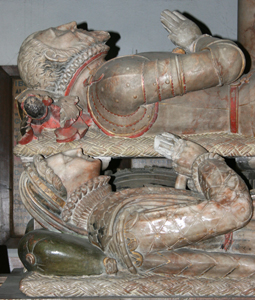
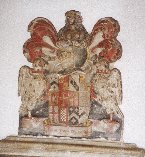
Lewis, 3rd Baron Mordaunt of Turvey 21 Sep
1538 - 16 Jun 1601
Son of the second Lord John and his first wife, Eleanor. He was made the third Baron of Turvey on his father's death in 1571.
Lewis was married to Elizabeth Darcy (no, not the one from Pride and Prejudice.)
Before his father's death, Lewis was a member of Parliament for Bedfordshire from 1563 until 1567.
Lewis was one of the judges at the trial of Mary, Queen of Scots and it is said that with her death sentence ' he did ‘mose unwillingly concur'.
He commanded troops when it was thought that the Spanish Armada would invade.
He died at his manor house in Drayton, Northants and was buried in Turvey in 1601. His is the plain black marble tomb in the church.
The title and property passed to his son, Henry.
Henry, 4th Baron Mordaunt of Turvey 1564 - 1608
The fourth Baron, Lord Henry, was suspected of being a party to the famous Gunpowder Plot, when Guy Fawkes and his accomplices attempted to blow up the King in Parliament.
Lord Henry was sent to the Tower of London but managed to escape with his life after paying a steep fine to the Star Chamber. The fact that he was a Roman Catholic, I am sure, didn't help his cause. He had a son, also called Henry, who was buried at Turvey Church on 2 October 1610. The baron died in 1608, his long spell in captivity almost certainly hastening his end, but it is not known where he was buried.
Mordaunt Entries in the Turvey Parish Registers - 1602 - 1812
Please note that the spellings are from the original transcription:
1610 Dec 4 -
1622 Jan 23 -
1676 May 18 -
1697 Jun 29 -
1702 24 Apr -
1709 28 May -
1709 March 1 -
1710 Apr 13 -
1715 Aug 5 -
1735 Nov 21 -
The Mordaunt Family in Turvey

Click here to see a family tree for Edmund Mordaunt of Turvey. (Opens in a new window)

Click here for a family tree of Anne-
Anne-

The Mordaunt Earls of Peterborough in Turvey

The Turvey Web Site -
This website and its content is copyright of Deborah Richardson -
Any redistribution or reproduction of part or all of the contents in any form is prohibited other than the following:
You may print or download to a local hard disk extracts for your personal and non-
You may copy the content to individual third parties for their personal use, but only if you acknowledge the website as the source of the material
You may not, except with our express written permission, distribute or commercially exploit the content. Nor may you transmit it or store it in any other website or other form of electronic retrieval system.

